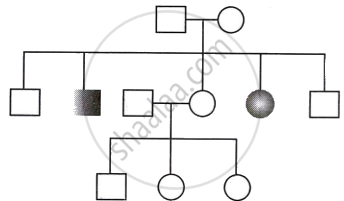Advertisements
Advertisements
प्रश्न
In a cross between two tall pea plants some of the offsprings produced were dwarf. Show with the help of Punett square how this is possible.
उत्तर
In a cross between two phenotypically tall plants, some of the progeny may turn out to be phenotypically dwarf. It means that both parents are heterozygous (Tt). The cross is demonstrated below by a Punnett Square.
Genotype of Parents = Tt.
Genotypic ratios of progeny after F1 cross= TT, Tt, Tt, tt.
Phenotypic ratios= 1 TT+ 2 Tt: 1 tt or 3 Tall: 1 dwarf
Case 1: Both parents hetrozygous

APPEARS IN
संबंधित प्रश्न
A cross was carried out between two pea plants showing the contrasting traits of height of the plants. The result of the cross showed 50% parental characters.
(i) Work out the cross with the help of a Punnett square.
(ii) Name the type of the cross carried out.
Explain polygenic inheritance pattern with the help of a suitable example.
A teacher wants his/her students to find the genotype of pea plants bearing purple coloured flowers in their school garden. Name and explain the cross that will make it possible
Mention any two contrasting traits with respect to seeds in pea plant that were studied by Mendel.
A plant of F1 generation has genotype “AABbCC”. On selfing of this plant, the phenotypic ratio in F2 generation will be ______.
______ is a type of trait whose phenotype is influenced by more than one gene.
Multiple phenotypes is seen in:
For the expression of traits genes provide only the potentiality and the environment provides the opportunity. Comment on the veracity of the statement.
A, B, D are three independently assorting genes with their recessive alleles a, b, d respectively. A cross was made between individuals of Aa bb DD genotype with aa bb dd. Explain the type of genotypes of the offspring produced.
The pedigree chart given below represents the pattern of inheritance of thalassemia in a family.

What could be the genotype of the affected male?
